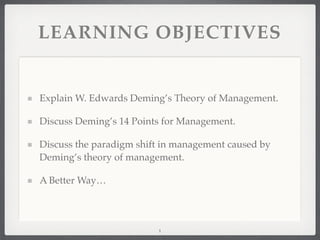
Theory of management (rev03.1)
- 1. LEARNING OBJECTIVES Explain W. Edwards Deming’s Theory of Management. Discuss Deming’s 14 Points for Management. Discuss the paradigm shift in management caused by Deming’s theory of management. A Better Way… 1
- 2. 2
- 3. A LEADER IN THE QUALITY REVOLUTION W. Edwards Deming War on Bad Quality War on Wasted Production Costs. 3
- 4. W. EDWARD DEMING Ph.D. in physics and trained as a statistician Western Electric in the 1920s and 30s After World War II helped Japan implement his statistical quality control Deming became known in 1980 when the broadcast program entitled If Japan Can…Why Can’t We? Credited with having the greatest influence on quality management 4
- 5. W. EDWARD DEMING CONT. responsibility for quality improvement lies with top management 85 to 95 % of variation results from the system majority of poor quality in a system is caused by management higher levels of quality lead to higher levels of productivity Quality philosophy focused on reducing uncertainty and variability 5
- 6. BRIEF HISTORY OF QUALITY The front (left) side of the “Narmer Palette” shows 6 papyrus reeds under a falcon. Each papyrus reed represents 1,000 enemies captured by King Narmer. This Is a pictograph and is one of the earliest uses of statistics. 6
- 8. Another example of a quality issue in ancient times is found in the Code of Hammurabi dating from as early as 2000 BC. Item 229 states, "If a builder has built a house for a man, and his work is not strong, and the house falls in and kills the householder, that builder shall be slain." 8
- 9. TRADITIONAL VIEW OF CONFORMANCE TO SPECIFICATIONS No Loss LossLoss Tolerance 0 +1/16-1/16 9
- 10. MODERN MANAGEMENT frequently operates using the following assumptions (often without realizing it): 1. Rewards and punishments are the most effective motivators for people… 2. Optimization of every area in an organization leads to optimization of the entire organization… 3. Results are achieved by setting objectives… 10
- 11. MODERN MANAGEMENT 4. Quality is inversely related to quantity… 5. Rational decisions can be made based on guesswork and opinion… 6. Organizations can be improved by fighting fires… 7. Competition is a necessary aspect of life… 11
- 12. PURPOSE Deming's theory of management promotes “Joy in Work” for all of the stakeholders of an organization. Deming believed that joy in work will “unleash the power of human resource contained in intrinsic motivation. Intrinsic motivation is the motivation an individual experiences from the sheer joy of an endeavor.” 12
- 13. 4 Paradigms Think of each as a shift in assumptions for the practice of management. 13
- 14. 1. People are best inspired by a mix of intrinsic and extrinsic motivation, not only by extrinsic motivation. 2. Manage using both a process and results orientation, not only a results orientation. 3. Management's function is to optimize the entire system so that everyone wins, not to maximize only their component of the system. 4. Cooperation works better than competition, if the aim of the system is not to win. 14
- 15. SYSTEM OF PROFOUND KNOWLEDGE Appreciation for a system Understanding variation Theory of knowledge Psychology 15
- 16. SYSTEMS A system is a set of functions or activities within an organization that work together for the aim of the organization. Components must work together Management must optimize the system Every system must have a purpose 16
- 17. 17
- 18. VARIATION Many sources of uncontrollable variation exist (common causes) Special (assignable) causes of variation can be recognized and controlled Failure to understand these differences can increase variation in a system Taguchi philosophy seeks to minimize variation around a target value (Fishbone diagram) 18
- 19. SOURCES OF VARIATION IN A PROCESS Materials Tools Operators Methods Measurement Instruments Human Inspection Performance EnvironmentMachines INPUTS PROCESS OUTPUTS 19
- 20. THEORY OF KNOWLEDGE Knowledge is not possible without theory Experience alone does not establish a theory, it only describes (“Ive been doing this for 30 years”) Theory shows a cause and effect relationship that can be used for prediction 20
- 21. PSYCHOLOGY Sincere trust and belief in people Understanding of how people work in systems People are motivated intrinsically and extrinsically; intrinsic motivation is the most powerful Fear is demotivating Managers should develop pride and joy in work 21
- 22. PEOPLE ARE DIFFERENT They learn in different ways and at different speeds. A leader of people must use these differences to optimize the system of interdependent stakeholders of an organization. Sources of power Power from position Power from personality Power from knowledge 22
- 23. DEMING’S 14 POINTS (ABRIDGED) (1 OF 2) 1. Create and publish a company mission statement and commit to it. 2. Learn the new philosophy. - Customer driven continuous improvement 3. Understand the purpose of inspection. - workers must be responsible for their work 4. End business practices driven by price alone. - Price has no meaning without quality 5. Constantly improve production and service as a system. 6. Institute training. - Job specific training 23
- 24. DEMING’S 14 POINTS (2 OF 2) 24 7. Teach and institute leadership. 8. Drive out fear and create trust. 9. Optimize team and individual efforts. 10. Eliminate exhortations for work force. -Giving advise 11. Eliminate numerical quotas and M.B.O. -Focus on improvement. 12. Remove barriers that rob people of pride of workmanship. 13. Encourage education and self-improvement. 14. Take action to accomplish the transformation.
- 25. 25
- 26. DEMING PRIZE Instituted 1951 by Union of Japanese Scientists and Engineers (JUSE) in Japan Several categories including prizes for individuals, factories, small companies, and Deming application prize American company winners – Florida Power & Light (first U.S. winner) 26
